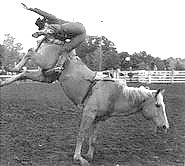IS RODEO BRONC RIDING CRUEL?
By: Staff Date: 01/16/2012 Category: | Animals in Education & Entertainment | Farm and Ranch Almanac |
- Flank Straps
A myth is a powerful thing. Every time there is a slow news day or a rodeo returns to town, animal rights groups bring the debate over rodeo bronc riding and cruelty to the front again. The myth that rodeo bronc riding is cruel because a horse only bucks because it is being treated cruelly and is in pain is a persistent favorite of many animal rights activists. The facts to these claims are so contradictory to the truth, however, that the people who perpetuate the myth are frequently forced to give it up because no one is listening.
 Bronc riding, as an event in a sport that would eventually be named rodeo, began in America in the mid to late 1800's. Like most of the events in early rodeo, bronc riding's origins stemmed from the lives of working cowboys, and the event was intended to mimic a cowboy's first ride on a healthy, fully grown, wild horse. From the very beginning a fresh supply of horses was constantly in demand for the event because the horses would quickly adapt to and accept a rider, and most of them quit bucking very quickly. A horse that would buck well and continue to do it, was rare, highly prized, and in demand. This is the type of horse that became known as a "bronc."
Bronc riding, as an event in a sport that would eventually be named rodeo, began in America in the mid to late 1800's. Like most of the events in early rodeo, bronc riding's origins stemmed from the lives of working cowboys, and the event was intended to mimic a cowboy's first ride on a healthy, fully grown, wild horse. From the very beginning a fresh supply of horses was constantly in demand for the event because the horses would quickly adapt to and accept a rider, and most of them quit bucking very quickly. A horse that would buck well and continue to do it, was rare, highly prized, and in demand. This is the type of horse that became known as a "bronc."
Today, the basic concepts of what a rodeo bronc is hasn't changed. A rodeo bronc must buck exceptionally well, and continue to do it. Since the myth that a bronc bucks because it is being treated cruelly focuses largely from the use of a piece of equipment used in the sport known as flank strap, we'll use the remainder of this article to take a closer look at what a flank strap is, why it is used, and what it can and cannot do.
Flank Straps
A flank strap is a piece of equipment positioned in the flank of a bucking horse. The outside of the "flank" is typically leather, and the inside, the side that touches the horse, is lined with sheepskin or neoprene. A flank strap is used to alter the bucking action of the horse by encouraging him to kick out higher and straighter with his hind legs. The flank strap stacks the odds in favor of the horse, and it cannot not make him buck.
The most often repeated fallacy regarding flank straps is that they are designed to cause a horse pain, usually described as putting painful pressure either on a horse's kidneys or genitals. However, a flank strap cannot put pressure on the kidneys as they are shielded by the horse's rib cage, and one quick look underneath a male or female horse lets one know it is physically impossible to cover the genitals with a flank strap.
That painful pressure on the flanks alone is enough to make a horse buck violently is another falsehood. In fact, causing a horse pain with pressure in the flanks makes a horse reluctant to move. Intentionally putting painful pressure in the flank area of a large animal is a very old technique called "girding." Before modern pharmaceuticals such as tranquilizers were common, girding was often used to restrain large animals for medical treatment. To pull a flank strap too tightly on a rodeo animal would cause him to be reluctant to move, let alone buck in the powerful, athletic and wide range of motion required of a rodeo bronc.
Last but certainly not least, even a flank strap that is not causing a horse pain cannot make him buck. On a true bronc the flank alters the bucking action of the bronc as described earlier. On a horse with no interest in bucking the flank strap might momentarily surprise a horse and cause it to take a couple of half?hearted leaps, but more often has no effect at all. Watching a reported "man killer" gallop happily to the end of the arena - bronc rider on board and flank strap in place - is a frustrating sight witnessed all too often by a stock contractor auditioning a potential new bronc.
About The Author
All Authors Of This Article: | Emma Carpenter |











